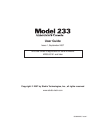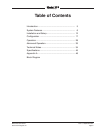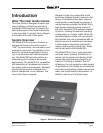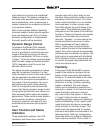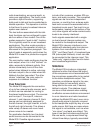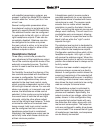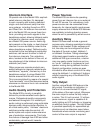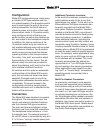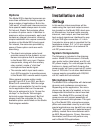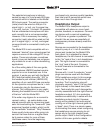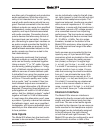
Issue 1, September 2007 Model 233 User Guide
Page 8 Studio Technologies, Inc.
radio broadcasting, announce-booth, or
voice-over applications. The fourth mode
provides a hybrid function, supporting
both push-to-talk and tap-to-enable/tap-to-
disable operation. This operation is similar
to that found in many broadcast intercom
system user stations.
The two buttons associated with the talk-
back functions can be configured to oper-
ate from either of two modes. One of the
modes supports a “push-to-talk” function.
This is typically used for on-air broadcast
applications. The other mode provides a
hybrid function, the operation of which is
discussed in the previous paragraph. The
hybrid mode is especially useful when the
Model 233 is used in a production-support
application.
The main button mode configures how the
main output, when it is in the “latched” on
state, responds to talkback activity. One
choice momentarily turns off the main
output when talkback is active, returning
the main output to the on state when the
talkback function has ended. The other
choice “unlatches” the main output in
response to a talkback function.
Cue Sources
The Model 233 supports the connection
of up to four external audio sources, each
of which can be selected for routing to
the stereo headphone output. The sources
are line input 1, line input 2, intercom
channel 1, and intercom channel 2. Each
source can be individually assigned to
the left channel, the right channel, or both
the left and right channels. This allows a
wide variety of stereo and mono head-
phone mixes to be created.
For application flexibility, two line-level
audio sources can be connected to the
Model 233. Possible signal sources
include off-air receivers, wireless IFB sys-
tems, and audio consoles. The connected
signals can be from two independent
sources, or could be from a stereo audio
feed such as would be associated with a
broadcast music event. Two level trim po-
tentiometers, located on the bottom of the
unit, allow signals with wide nominal audio
levels to be cleanly interfaced.
Audio signals associated with a single-
or dual-channel intercom system can
be routed to the headphone output. The
Model 233’s intercom interface is com-
patible with standard party-line intercom
systems from manufacturers such as
RTS™ and Clear-Com®. A broadcast-type
IFB (interrupted foldback) circuit can also
be connected to the intercom input. This
“listen only” signal is often found in televi-
sion broadcast applications.
Sidetone
The Model 233 includes an integrated
sidetone function that allows the output
of the compressor circuit associated with
the microphone preamplifier to be routed
to the stereo headphone output. This
provides a confidence signal to the user,
allowing them to hear exactly what is
being sent to the main and, if desired,
talkback outputs. This sidetone signal
can be a critical element when creating
an effective communications environment.
In on-air television and radio broadcast
settings the Model 233 user’s own micro-
phone audio signal is typically returned
to the headphone output by way of a cue
audio source. But there are cases where
this signal is not available, such as when
“mix minus” cue feeds are utilized. This
type of cue feed includes everything but
the user audio, a requirement when sig-
nificant time delays, typically associated



